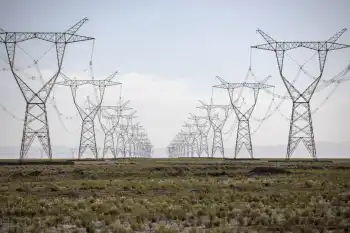California asks FERC to weigh in on power line
By Associated Press
Electrical Testing & Commissioning of Power Systems
Our customized live online or in‑person group training can be delivered to your staff at your location.

- Live Online
- 12 hours Instructor-led
- Group Training Available
Southern California Edison on Friday asked the Federal Energy Regulatory Commission to begin proceedings that could eventually lead to an override of the Arizona Corporation Commission's denial of a cross-desert line between the two states.
However, an Edison executive said the company hopes to revise its proposal in a way that would allow it to win approval from Arizona regulators.
Edison's request to FERC is the first by a utility under a 2005 federal law that led to U.S. Department of Energy designations of critically congested electrical corridors in the Southwest and Northeast. The designations permit FERC to authorize new transmission projects rejected by states.
Rosemead, Calif.-based Edison's "initial filing" asked federal regulators to begin considering the utility's proposed 230-mile line between Phoenix and Palm Springs, Calif., an area that's part of one the Arizona-California-Nevada corridor.
The other corridor is in the mid-Atlantic region.
FERC spokeswoman Mary O'Driscoll said the agency next will review the filing before examining possible ways to resolve the issue. Ultimately, it could lead to Edison making a formal application for permission to build the line despite Arizona's objections, she said.
"We hope that we don't have to do that at all," said Les Starck, an Edison vice president. "We are really committed to work with Arizona stakeholders to find a way to reconfigure the project in a way that benefits Arizona. But to preserve our options under the Energy Policy Act, that's why we're... moving forward through the process."
The Edison International subsidiary says the line is needed to reduce congestion in the corridor while allowing utilities to improve access to underused gas-fired plants in south-central Arizona but also renewable sources.
In addition to the request to FERC, Edison said it has asked California regulators to allow the start of construction of new power interconnection projects that would be on the western end of the new line.
However, Edison said it still considers completion of the entire line as vital.
The Arizona commission recently urged FERC to turn Edison away.
Arizona has approved numerous generating and transmission projects but was justified in rejecting Edison's application because it had weighed environmental concerns and economic benefits associated with the proposal, the Arizona commission's chairman said in a letter to FERC.
The Arizona commission contends that benefits for the regional grid are questionable and Edison has power options, such as building new plants and using renewable resources.
Starck said a possible revision to the plan would be to include new switching features that could help Arizona connect with new renewable energy sources.
"It provides benefits across the board," Starck said. "This line between Arizona provides tremendous regional benefits."
A member of the Arizona commission voiced frustration Edison has not put a revised proposal on the table.
A revised plan still would have to be measured against projected increases in power costs for Arizona consumers, according to Commissioner Kris Mayes. "We will review it but the bar is high," she said.











